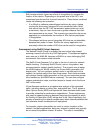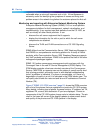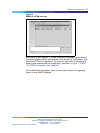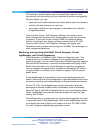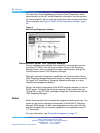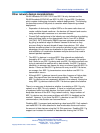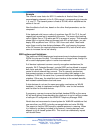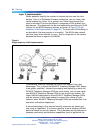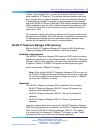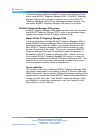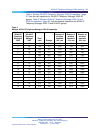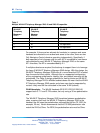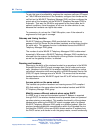
Other network design considerations 57
Example
The channel reuse factor for 802.11b networks is fixed at three (three
nonoverlapping channels in the 2.4 GHz range), corresponding to channels
1, 6, and 11. The transmit power is fixed at 50 mW, which establishes the
radius of the cell.
Now the effects of cell size, based on the other fixed parameters, can be
compared.
If the deployed cells have a radius of anywhere from 33 ft to 75 ft, the call
capacity per square foot is essentially the same. This means that packing
cells in tighter than a 75 ft radius per AP is a waste of money. This example
shows that in a typical office environment with APs at half power, you can
deploy APs anywhere from 100 ft to 150 ft from each other. More walls
mean there must be less distance between APs, and lowering the power
of the AP lessens the required distance between APs, both of which also
serve to increase the net call density.
SSID options and limitations
The traditional WLAN deployment requirement was to implement separate
SSIDs for voice and for data. This requirement no longer exists, though it is
still a useful deployment option in some circumstances.
If all devices implement common security encryption mechanisms (for
example, Wi-Fi Protected Access), a single SSID can be offered to support
both voice and data. The benefit of this configuration is that users cannot
control to which network they connect. This is a security mechanism
that prevents curious or malicious users from putting their laptops in the
telephony VLAN. At the same time, it prevents inadvertent configuration
mistakes. Either way, the simplified user interface to the network benefits
both network administrators and end users.
If data devices do not use the same encryption mechanism as WLAN
handsets, it is best to implement multiple SSIDs—one for the handsets
and the other for the data devices.
If necessary, one way to ensure that multiple handset SSIDs on the same
AP still work without oversubscribing the medium is to cut in half the number
of calls per AP configured on the WLAN IP Telephony Manager 2245.
Nortel does not recommend a closed system for VoWLAN installations that
use more than one SSID, including converged data and voice WLANs.
The reason is that the SSID serves a valuable purpose in roaming. When
it is hidden by not being included in the beacon, roaming devices must
attempt to try all closed system APs. This result can dramatically impact
call handoff times.
Nortel Communication Server 1000
WLAN IP Telephony Installation and Commissioning
NN43001-504 01.02 Standard
Release 5.0 15 June 2007
Copyright © 2004-2007, Nortel Networks
.



